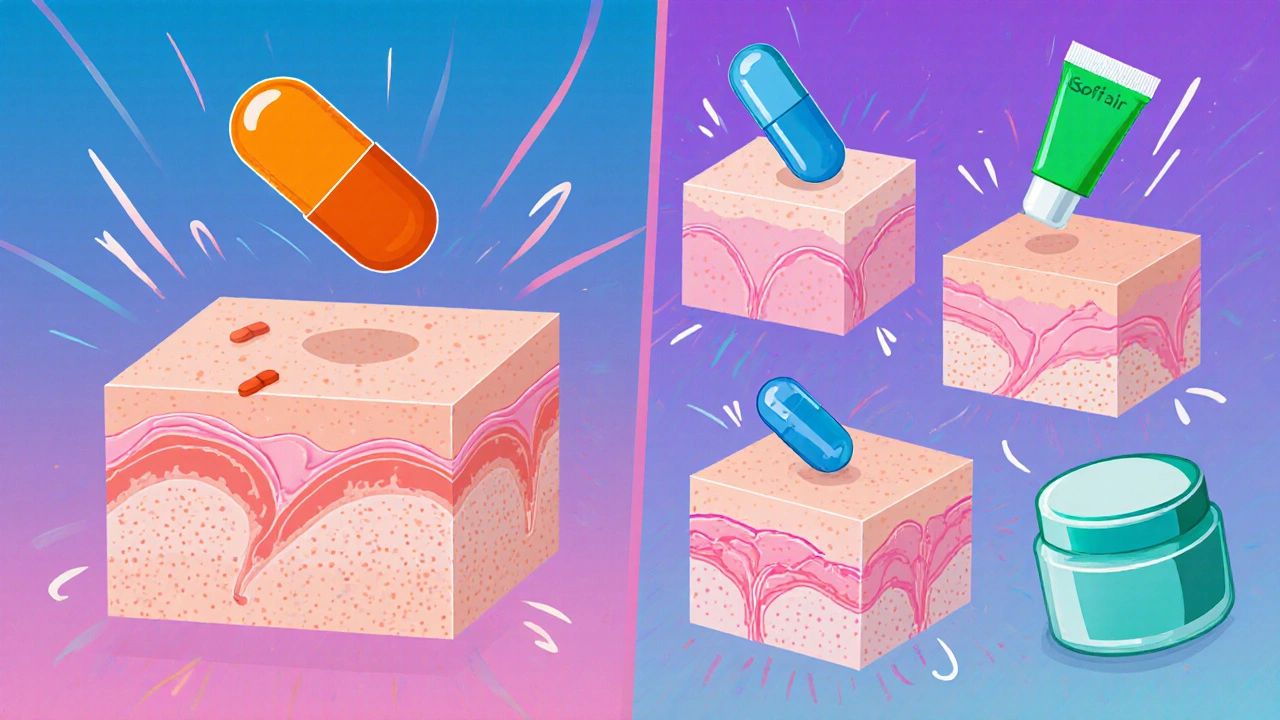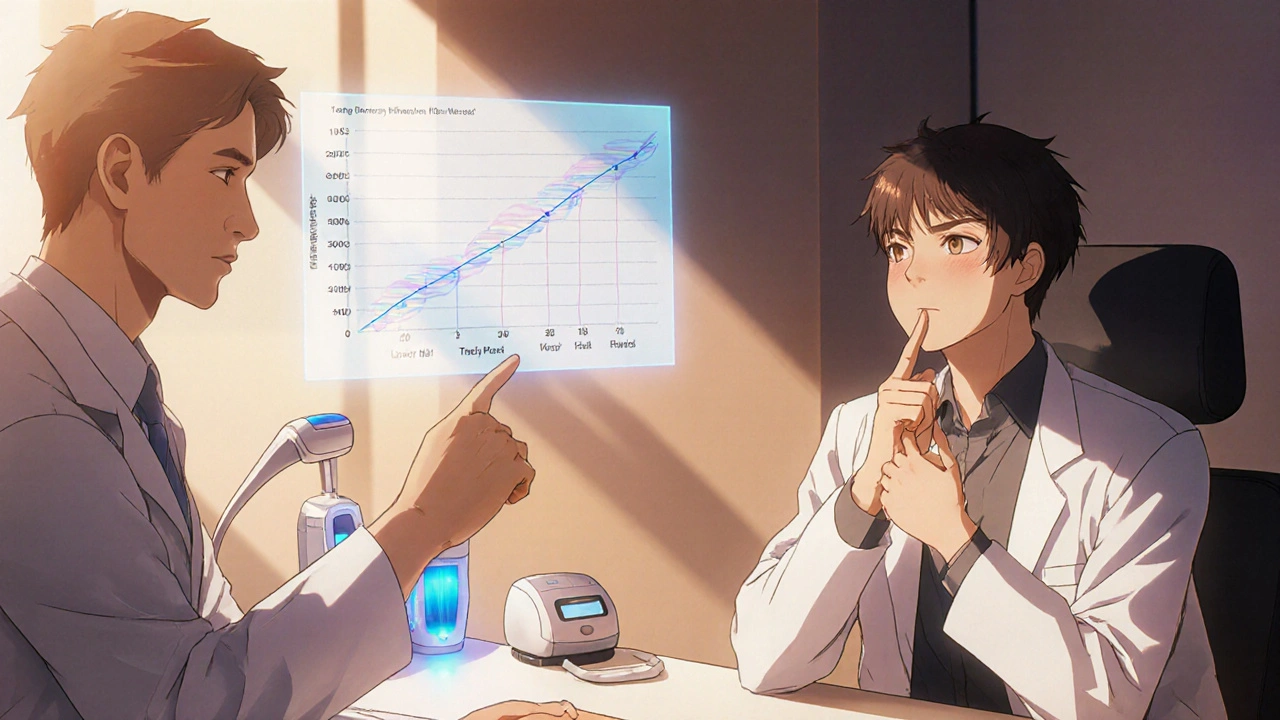When severe acne refuses to budge, many people wonder whether Isofair is worth the hype or if there’s a safer, cheaper option. Below you’ll find a side‑by‑side look at Isofair (the brand name for isotretinoin) and the most common alternatives, so you can decide what fits your skin, lifestyle, and budget.
What is Isofair (Isotretinoin)?
Isofair is a prescription‑only oral retinoid that contains the active ingredient Isotretinoin. It was originally developed for severe nodular acne that hasn’t responded to topical creams or antibiotics.
Typical dosing ranges from 0.5 mg/kg to 1 mg/kg per day, taken for 4-6 months. Because it attacks acne from the root-reducing oil production, normalising skin cell turnover, and dampening inflammation-it can clear up to 80-90 % of lesions in many patients.
How does isotretinoin work?
Isotretinoin binds to retinoic acid receptors in skin cells, shutting down the overactive sebaceous glands that feed acne‑causing bacteria. It also thins the top layer of skin, preventing clogged pores. The result is fewer breakouts, less scarring, and often a permanent reduction in acne severity.
Who should consider Isofair?
- Patients with severe nodular or cystic acne that hasn’t improved after 6 months of topical or oral antibiotics.
- Individuals who are prepared for strict pregnancy‑prevention measures (isotretinoin is teratogenic).
- People willing to undergo regular blood‑work to monitor liver enzymes and lipids.
If you fit any of these criteria, Isofair can be a life‑changing option-provided you manage the side‑effects responsibly.

Common alternatives to Isofair
Below are the most frequently prescribed or over‑the‑counter alternatives, each with its own strengths and drawbacks.
- Accutane - the original isotretinoin brand, now discontinued in many markets but still referenced in older literature.
- Doxycycline - a tetracycline antibiotic that reduces inflammation and bacterial growth.
- Benzoyl peroxide - a topical oxidizing agent that kills acne bacteria and helps unclog pores.
- Combined oral contraceptives (COCs) - hormonal pills that lower sebum production in many women.
- Tretinoin - a topical retinoid used for milder acne and post‑acne hyperpigmentation.
- Light‑based therapies (e.g., blue‑light or laser) - non‑drug options that target bacteria and inflammation.
- Chemical peels (salicylic or glycolic acid) - professional procedures that exfoliate the skin surface.
Side‑effect snapshot
Understanding the safety profile helps you weigh risk versus reward. Isofair’s most notable adverse effects include dry skin, cheilitis (chapped lips), elevated triglycerides, and, in rare cases, mood changes. The alternatives each carry their own set of issues: doxycycline can cause photosensitivity; benzoyl peroxide may irritate; hormonal pills bear a clotting risk; tretinoin can cause irritation.
Detailed comparison table
| Attribute | Isofair (Isotretinoin) | Accutane (brand) | Doxycycline | Benzoyl Peroxide | Combined Oral Contraceptives | Tretinoin (topical) |
|---|---|---|---|---|---|---|
| Form | Oral capsule | Oral capsule | Oral tablet | Topical gel/cream | Oral tablet | Topical cream |
| Typical Dose | 0.5-1 mg/kg daily | 0.5-1 mg/kg daily | 100 mg twice daily | 2.5-5 % concentration | 0.02-0.03 mg estrogen + progestin | 0.025-0.05 % concentration |
| Treatment Length | 4-6 months | 4-6 months | 3-6 months | Indefinite, as needed | 3-6 months (cycle) | Indefinite, as needed |
| Clearance Rate | 80-90 % | 80-90 % | 30-50 % | 20-40 % | 30-45 % (women only) | 20-35 % |
| Major Side‑effects | Dry skin, cheilitis, ↑ triglycerides, teratogenic | Same as Isofair | Photosensitivity, GI upset | Skin irritation, bleaching of fabrics | Blood clots, hypertension | Skin irritation, sun sensitivity |
| Pregnancy Risk | Category X (contraindicated) | Category X | Category B (relatively safe) | Category C (use caution) | Category C (depends on formulation) | Category C |
| Typical Cost (UK) | £120-£180 per course | £130-£190 (when available) | £30-£45 per 3‑month pack | £15-£25 per 30 g tube | £20-£35 per month | £10-£20 per tube |

Pros and cons of each option
- Isofair (Isotretinoin)
- Pros: Highest clearance, long‑term remission, works on all acne types.
- Cons: Requires pregnancy‑prevention programme, regular blood tests, potential mood effects.
- Accutane
- Pros: Same efficacy as Isofair, widely studied.
- Cons: Often harder to obtain, same safety profile as Isofair.
- Doxycycline
- Pros: Easy to prescribe, relatively cheap, good for inflammatory lesions.
- Cons: Does not tackle oil production, resistance can develop, sun sensitivity.
- Benzoyl peroxide
- Pros: Over‑the‑counter, kills bacteria instantly, prevents resistance.
- Cons: Can bleach clothes, may cause excessive dryness.
- Combined oral contraceptives
- Pros: Addresses hormonal acne, also offers birth control.
- Cons: Not suitable for smokers over 35, clot risk, only works for women.
- Tretinoin
- Pros: Improves skin texture, treats post‑acne marks.
- Cons: Slower results, irritation common, needs sunscreen.
How to choose the right treatment
- Assess severity. If you have nodules or cysts that scar easily, oral retinoids (Isofair) are usually the first‑line choice.
- Check contraindications. Pregnancy potential, liver disease, or lipid disorders rule out isotretinoin.
- Consider lifestyle. If you travel often and can’t commit to monthly blood tests, a topical or antibiotic may be more practical.
- Factor cost. While Isofair has a higher upfront price, its shorter course may end up cheaper than years of antibiotics plus topicals.
- Talk to a dermatologist. A professional can run baseline labs, set up a pregnancy‑prevention programme, and match your skin type to the best regimen.
Remember, acne treatment isn’t one‑size‑fits‑all. Many patients combine two or three options (e.g., low‑dose isotretinoin plus benzoyl peroxide) to maximise benefits while minimising side‑effects.
Frequently Asked Questions
Is Isofair the same as Accutane?
Yes. Both contain the same active ingredient, isotretinoin. Accutane was the original brand name; Isofair is the newer branding used in the UK and some EU markets.
How long does it take to see results with Isofair?
Most patients notice a significant reduction in new lesions within 6-8 weeks, but the full clearance often requires the entire 4-6 month course.
Can I use benzoyl peroxide while on isotretinoin?
Yes, many dermatologists pair a low‑dose benzoyl peroxide gel with isotretinoin to reduce bacterial resistance and speed up acne clearance. Start with a low concentration to avoid excessive dryness.
What monitoring is required during treatment?
Baseline liver function tests, fasting lipid panel, and pregnancy test (for women of childbearing age). Follow‑up labs are typically done every 4-6 weeks.
Are there non‑drug options for severe acne?
Laser and light‑based therapies, chemical peels, and professional extraction can help, but they usually complement rather than replace isotretinoin for nodular acne.

Alex Lineses
October 18, 2025 AT 19:57Hey folks, let’s break down the pharmacodynamics of Isofair in plain terms. The drug binds to retinoic acid receptors, attenuating sebaceous gland hyperactivity – that’s the core of its high clearance rate. It does require baseline LFTs, lipid panels, and a strict iPLEDGE protocol for teratogenic risk mitigation. If you’ve struggled with refractory nodular acne, the benefit‑risk profile often justifies the monitoring overhead. Remember, adherence to the dosing schedule (0.5‑1 mg/kg/day) maximizes therapeutic outcomes while minimizing adverse events.
kendra mukhia
October 23, 2025 AT 11:04Seriously? You’re still debating a drug that clears up 90% of lesions while the alternatives merely dabble in surface‑level tricks. The drama of watching “mild” treatments fail for months is exhausting, and the judgmental whisper that you’re “just lazy” is unfair. Isofair isn’t a gimmick; it’s a clinical powerhouse that has reshaped severe acne management. If you can’t commit to the pregnancy‑prevention program and bi‑weekly labs, maybe stick to benzoyl peroxide and call it a day.
Grace Hada
October 28, 2025 AT 02:10If you can’t tolerate dry skin and cheilitis, don’t waste money on isotretinoin.
alex montana
November 1, 2025 AT 17:17Wow!!! You think a little chapped lip is a deal‑breaker??? Think again!!! The skin barrier adapts, and you’ll be rolling in confidence-soon enough!!
Wyatt Schwindt
November 6, 2025 AT 08:24Monitoring labs every month is essential.
Lyle Mills
November 10, 2025 AT 23:30Monthly LFTs and triglyceride panels keep the therapy within therapeutic index while preserving hepatic function.
Barbara Grzegorzewska
November 15, 2025 AT 14:37Isofair is da bomb – it hits those stubborn cysts like a ninja‑master, while the cheaper stuff just sits there, playing peek‑a‑boo with your pores. No more endless cycles of antibiotics that just make your skin a desert. Trust me, the side‑effects are worth the glow‑up, especially when you’re ready to ditch the teen‑age acne drama for good. If you’re still scared of the “teratogenic” buzzkill, just remember it’s a “do‑not‑pregnant” rule, not a mystery.
Nis Hansen
November 20, 2025 AT 05:44Understanding the biochemical cascade that Isofair initiates is like watching a symphony of cellular reprogramming unfold. First, the drug's affinity for nuclear retinoic acid receptors modulates gene expression, curbing sebum synthesis at its source. This upstream control dwarfs what topical agents can achieve, which merely address the symptomology, not the etiology. Second, the concomitant decrease in Propionibacterium acnes colonization reduces inflammatory mediators, leading to fewer papules and nodules. Third, the long‑term remission observed in many patients speaks to a true disease-modifying effect, not just temporary palliation. Fourth, the required laboratory surveillance-ALT, AST, and fasting lipids-provides a safety net that safeguards hepatic and metabolic health. Fifth, the iPLEDGE system, while bureaucratic, ensures that teratogenic risk is mitigated through mandatory contraception and regular pregnancy testing. Sixth, the psychosocial boost from clear skin can improve self-esteem, academic performance, and even professional opportunities. Seventh, while the cost may appear steep upfront, the cumulative expense of years of antibiotics, topical concoctions, and procedural interventions often surpasses a single course of Isofair. Eighth, integrating low‑dose benzoyl peroxide can alleviate bacterial resistance, optimizing outcomes. Ninth, patient education on moisturization and lip balm usage addresses the dry skin and cheilitis side‑effects promptly. Tenth, emerging data suggest a favorable impact on post‑acne scarring, likely due to reduced inflammatory trauma. Eleventh, clinicians should tailor the dose to body weight to balance efficacy with tolerability. Twelfth, the therapeutic window allows for dose adjustments mid‑course if side‑effects become burdensome. Thirteenth, the psychological profile of patients should be monitored, as mood alterations, though rare, require attention. Fourteenth, the ultimate goal is not merely clear skin but sustaining it without dependence on perpetual medication. Finally, a collaborative decision‑making process between dermatologist and patient cultivates adherence, empowering individuals to achieve lasting dermatologic health.